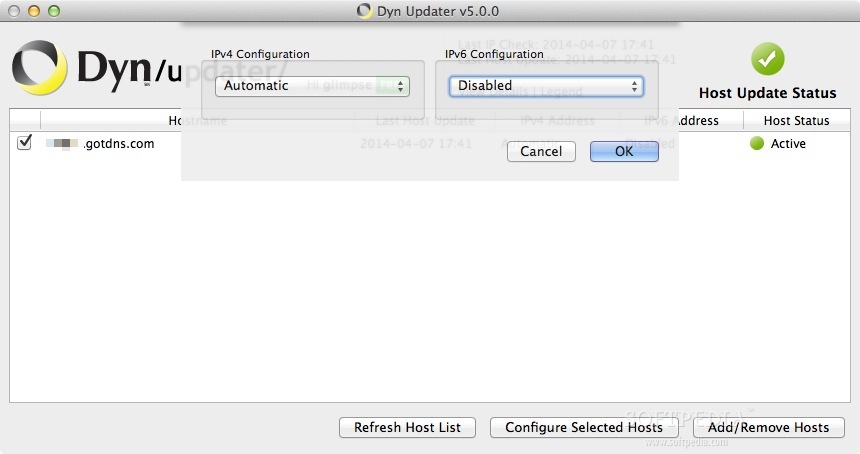

- #Dyn updater alternative update
- #Dyn updater alternative password
Use a webserver as a proxy to handle SSL and/or multiple listen addresses and ports.
use any IP address used by the connecting HTTP client. when used behind HTTP reverse proxy such as nginx, or use any IP address provided via the X-Real-IP header e.g. use any IP address provided via the myip parameter when present, or. MYIP is optional and the HTTP client's address will be used if missing. #Dyn updater alternative update
HOSTNAMES is a required list of comma separated FQDNs (they all have to end with your config.yaml domain) the user wants to update.PORT depends on your (webserver/proxy) settings.

DOMAIN should match what you defined in your config.yaml as domain but may be anything else when using a webserver as proxy.
#Dyn updater alternative password
USER and PASSWORD are needed for HTTP Basic Auth and valid combinations are defined in your config.yaml. The update URL you want to tell your clients (humans or scripts ^^) consists of the following the protocol depends on your (webserver/proxy) settings Please provide ideas if you are using dyndnsd.rb with other DNS servers :) Advanced topics Update URL Start dyndnsd.rb before NSD to make sure the zone file exists else NSD complains. NSD is a nice opensource, authoritative-only, low-memory DNS server that reads BIND-style zone files (and converts them into it's own database) and has a simple config file.Ī feature NSD is lacking is the Dynamic DNS update functionality BIND offers but one can fake it using the following dyndnsd.rb config: host : "0.0.0.0" port : "8245" # the alternative HTTP port db : "/opt/dyndnsd/db.json" domain : "" updater : name : "command_with_bind_zone" params : # make sure to register zone file in your nsd.conf zone_file : "/etc/nsd3/" # fake DNS update (discards NSD stats) command : "nsdc rebuild nsdc reload" ttl : "5m" dns : "." email_addr : "." # specify additional raw BIND-style zone content # here: an A record for itself additional_zone_content : IN A 1.2.3.4" users : foo : password : "secret" hosts :. Run dyndnsd.rb by: dyndnsd /path/to/config.yaml General UsageĬreate a configuration file in YAML format somewhere: # listen address and port host : "0.0.0.0" port : "80" # optional: drop priviliges in case you want to but you may need sudo for external commands user : "nobody" group : "nogroup" # logfile is optional, logs to STDOUT else logfile : "dyndnsd.log" # interal database file db : "db.json" # all hostnames are required to be domain : "" # configure the updater, here we use command_with_bind_zone, params are updater-specific updater : name : "command_with_bind_zone" params : zone_file : "dyn.zone" command : "echo 'Hello'" ttl : "5m" dns : "." email_addr : "." # user database with hostnames a user is allowed to update users : # 'foo' is username, 'secret' the password foo : password : "secret" hosts : - test : password : "ihavenohosts" There is currently one updater shipped with dyndnsd.rb command_with_bind_zone that writes out a zone file in BIND syntax onto the current system and invokes a user-supplied command afterwards that is assumed to trigger the DNS server (not necessarily BIND since it's zone files are read by other DNS servers too) to reload it's zone configuration.īecause of the mechanisms used dyndnsd.rb is known to work only on *nix systems. 
Besides talking the DynDNS protocol it is able to invoke an so-called updater, a small Ruby module that takes care of supplying the current host => ip mapping to a DNS server. It has an integrated user and hostname database in it's configuration file that is used for authentication and authorization. Descriptionĭyndnsd.rb aims to implement a small DynDNS-compliant server in Ruby supporting IPv4 and IPv6 addresses. A small, lightweight and extensible DynDNS server written with Ruby and Rack.







 0 kommentar(er)
0 kommentar(er)
